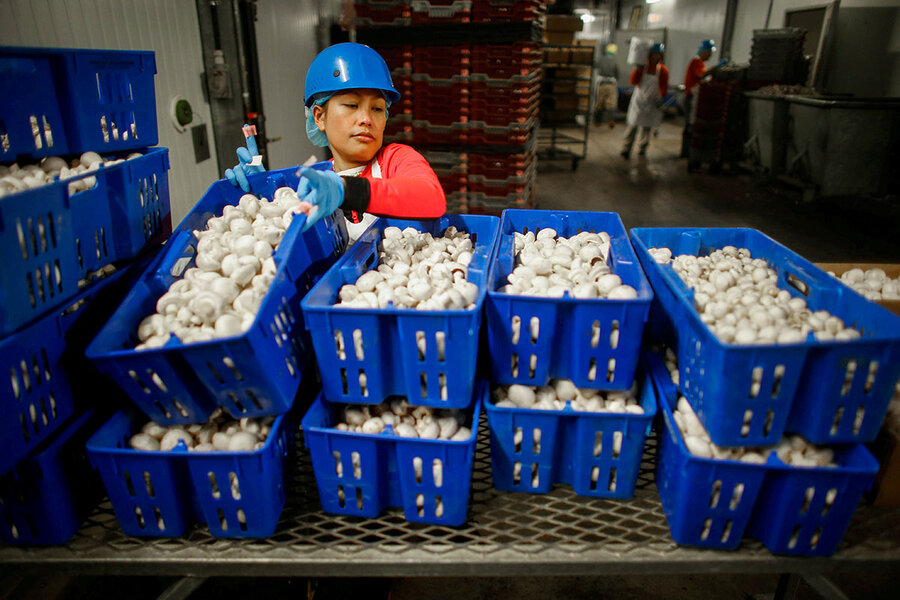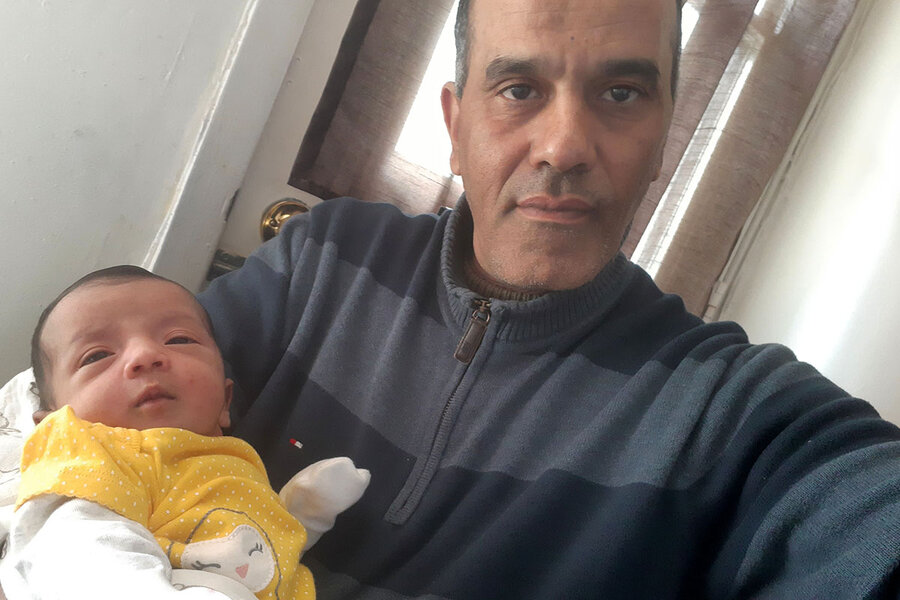Migrants have helped Canada weather the pandemic. Will it return the favor?
Loading...
| Toronto and Montreal
Canada’s migrant agricultural and health care workers and asylum-seekers are increasingly seeking permanent residence in the country. And many Canadians agree that the essential nature of their work and sacrifice, during the biggest modern threat to Canadian life, should be recognized.
Quebec, the epicenter of Canada’s COVID-19 crisis, has leaned heavily on asylum-seekers to fill in its depleted long-term care facilities, which have been ravaged by the pandemic. More than a thousand asylum-seekers are working in Quebec’s health care sector, and a large portion of them are nonwhite women who are living in poverty.
Why We Wrote This
Migrant workers are making significant sacrifices to benefit their host nations' well-being. In Canada, that includes braving the pandemic. At what point do these workers deserve the residency status they seek?
And as many as 60,000 temporary workers are laboring in the country’s critical agriculture and food production. This year’s program went forward with workers required to quarantine for 14 days upon arrival in Canada. But still the virus spread, many public health officials say, because of bunking arrangements.
Permanent residence for temporary workers would help protect them, says Edward Dunsworth, a historian at McGill University. It “wouldn’t solve every single issue,” he says. “But a lot of these problems really lead back to this issue of status.”
Juan Luis Mendoza has spent more of his adult life on Canadian soil than Mexican. For eight months of each of the last 30 years, the Mexican agricultural worker has harvested sunflowers, cabbage, peaches, and strawberries from Ontario farms – missing the graduations of his three daughters as they moved from elementary to high school to college.
Today as COVID-19 has swept through migrant farms – three agricultural workers in the province have already died and more than 1,000 have been infected among some of the worst outbreaks in Canada – he wipes a tear from behind his glasses. But not because of the virus or fear of it. “You remember all that you missed with your family, all those moments,” he says.
He recognizes all that he has gained by participating in Canada’s temporary foreign worker program, modeled after one in the United States. But he feels that the sacrifices he has made warrant permanent status. And now he says people are finally paying attention. “We have contributed to the development of Canada,” he says. “But we have been invisible, until this pandemic.”
Why We Wrote This
Migrant workers are making significant sacrifices to benefit their host nations' well-being. In Canada, that includes braving the pandemic. At what point do these workers deserve the residency status they seek?
Mr. Mendoza joins a growing movement of agricultural and health care workers and asylum-seekers seeking permanent residence here. And many Canadians agree that the essential nature of their work and sacrifice, during the biggest modern threat to Canadian life, should be recognized, much the way immigrants in the U.S. are fast-tracked to citizenship if they serve in the American military. Canadian Prime Minister Justin Trudeau has said he is looking into the possibility of granting asylum-seekers on the front lines of health care permanent status in Canada.
Editor’s note: As a public service, all our coronavirus coverage is free. No paywall.
They join a global movement sparked by the precarity that has been exposed by the pandemic. In Paris, more than 5,000 marched for legalization of the sans papiers, or unauthorized workers. In Portugal and Italy, governments have granted temporary rights to workers, while in Lebanon, where maids were abandoned by families who said they could no longer afford to pay, a push to end the “kafala system” in which domestic workers are tied directly to one family has grown. Over the weekend, asylum-seekers, unauthorized workers, and migrant workers protested in Canadian cities demanding more rights and protections amid the pandemic.
“It’s part of a broader reckoning during this pandemic, in the kind of profound irony and hypocrisy that a lot of the most essential workers in our economies are often the worst treated and lowest paid,” says Edward Dunsworth, a historian of migrant agricultural labor in Canada and soon assistant professor of history at McGill University in Montreal.
Guardian angels in a precarious situation
The movement for migrants has gained much traction in Quebec, the epicenter of Canada’s COVID-19 crisis, with half of all cases and more than 5,400 deaths. Some 80% of those have occurred in long-term care facilities, which were so depleted by the pandemic that the military had to come in to assist this spring. So too did asylum-seekers, says Wilner Cayo, an activist with the Quebec-based advocacy group Debout pour la dignité (Stand Up for Dignity). He says between 1,200 and 1,400 asylum-seekers are working in Quebec’s health care sector, including many from Haiti and North Africa, and a large portion of the workers are nonwhite women who are living in poverty.
Quebec Premier François Legault began referring to these home care workers as “guardian angels.” It’s a stark reversal from rhetoric that propelled him into office in the first place. In August 2017, he said Quebec couldn’t be expected to accept “all the world’s misery.”
Now many recognize the service of those escaping misery – men like L’Houcine El Arbane who came to Canada in 2016 and began a job as an orderly at a long-term care home north of Montreal in mid-April, making sure elderly patients there were well-fed, clean, and comfortable.
His first shift started a week after his daughter Ghalya was born. He didn’t want to worry his wife. But his own anxiety rose with each red marker placed outside residents’ rooms to mark positive COVID-19 cases. “I thought about quitting,” he says. “Every [day] you would see funeral homes [arriving] with their stretchers to pick up a patient who had passed away. They were long days – long, long days.”
Today as those numbers have gone down, he faces another uncertain road ahead. His original refugee claim was denied, and he resubmitted an application for permanent residence in March 2020. Now he waits.
Mr. Cayo says many asylum-seekers are suffering psychologically because they are unsure whether they will face deportation once the pandemic ends and their jobs are no longer deemed “essential.” “François Legault [compared them] to guardian angels. Justin Trudeau called them humanitarian workers. Yet despite that glowing rhetoric, we still left them in a precarious situation as to their migration status,” he says.
And the current proposals pertain narrowly to health care workers, launching a conversation about what “essential” means, and why food processors or security guards in care homes, for example, wouldn’t also fit the definition.
“This issue of status”
Patti Lenard, an associate professor at the University of Ottawa’s Graduate School of Public and International Affairs, says all of those who need protection in Canada should be granted it. Still she likens the moment to grant health care workers a path to residence to Mr. Trudeau’s promise in 2015 to resettle 25,000 Syrian refugees in Canada. The political class and the public were on board then just as they are today.
“There’s a political will here [today] in a government, which has been pretty reluctant to recognize the claims of asylum-seekers and refugees and is pretty hostile to certain categories of immigrants,” Dr. Lenard says.
Among them are temporary workers, who number as many as 60,000 every year to work in agriculture and food production. This year the program, central to Canada’s food security, was initially in doubt over possible border closures. It went forward with workers required to quarantine for 14 days upon arrival in Canada. But still the virus spread, many public health officials say, because of bunking arrangements.
Dr. Dunsworth says his research has shown that as programs have grown in scale since the first was established in 1966 – and as Canadian farming has become a more centralized, corporate industry – conditions have worsened for workers. But it’s been hard to draw attention to that, in part because of the program’s juxtaposition to American farming. “Because of how prevalent undocumented labor is on farms in the U.S., these managed migration programs are actually seen in a more positive light compared to the abuses and the ever-present dangers for undocumented workers,” he says.
He says permanent residence for temporary workers would protect them – giving them the power to walk away from an abusive boss, unsafe conditions, or, particularly relevant in today’s environment, poor living conditions. It doesn’t mean, he says, they would necessarily – or even want to – stay in Canada permanently. Permanent residence “wouldn’t solve every single issue,” he says. “But a lot of these problems really lead back to this issue of status.”
Syed Hussan agrees. As executive director of the Migrant Workers Alliance for Change in Toronto, he is trying to protect the rights and welfare of migrants, unauthorized workers, and refugees in Canada. But it is an uphill battle; for example, Ontario Premier Doug Ford recently changed rules to allow workers who test positive but are asymptomatic to continue working.
“I think it is very possible that there’s a huge instinct and a desire to return to normal,” Mr. Hussan says. “Normal was just not good enough.”
Editor’s note: As a public service, all our coronavirus coverage is free. No paywall.









